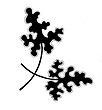RAISED BEDS
Our first inkling about how to use the big open area behind the Pol was to designate it as a parking place for visitors' cars. It had been a derelict space when we first saw it – much like the front of the Pol – and now we aimed to gladden it with plants, especially a passageway between 2 backward-trailing arms of the Pol.
But we had no inspired ideas about how else to make use of this open space until the following year... By the winter of 2013, even though we had made the parking spaces – including a chai sitout and a WC – we had begun to feel it was a waste of space.
This is when we first considered converting the parking lot into an outdoor exhibit about different kinds of PLANT HABITATS in the Thar.
_JPG.jpg)
Scouting for seeds in the desert, we’d often come across unusual or interesting plant habitats.

I learnt not to collect any seeds from these places. This was because all of their mineral soils of one kind or another were not compatible with the rhyolite-derived soil that we had inside Rao Jodha Park.
We came across limestone-rich soils, for instance which, of course, are fairly common in the Thar. And schist-derived soil in the hills near Barr. And deep sandy soils that have no analogues inside our volcanic rock Park. Iron-rich silica gravels. Ultra-fine clay minerals from ancient lagoons...
.jpg)

.jpg)
The desert is richly endowed with little pockets of special soils that you can often spot from quite far away because of their distinctive texture or colouring.
You can't help but stop to take a look. But then you have to turn around with a sigh because... what is the use of collecting from these places when the soil doesn't match what we have inside the Park?
_JPG.jpg)
.jpg)
Each of these tiny pockets house their own special suite of plants that have evolved to live and prosper inside those particular soils. So I got used to admiring and envying the unusual plants we saw in these habitats. I’d take lots of photographs but then return empty-handed because bringing back seeds served no useful purpose.
Until one day it struck me that if we could create sufficiently large containers and fill them with the right kinds of soil, maybe we’d be able to grow the plants that are adapted to do well in them.
We began by making one small bed raised about 3 feet above the stone parking floor and then brought in about 90 cubic feet of salty sand from the bed of the Luni river some 40 kilometres east of Jodhpur. We were careful to fill 2 emptied cement bags with soil scraped from the top 3 or 4 inches – this was likely to bear fallen seeds of the remarkable salt-tolerant plants that grow there.
.jpg)
After filling the raised bed with salty sand nearly to its brim, we scattered the seed-bearing soil on top. And then waited – not very patiently – for the rains that were still a few months away.
Even before we saw any results we sensed we were on the right track and replicated this procedure with dune sand from a place some 150 kilometres south of Jaisalmer. This container needed to be much deeper because plants that grow in dunes put a lot of their energy into growing enormously deep roots, so we dug down below the stone floor so that we had a column of nearly 8 feet of sandy soil.
Our first micro-habitat being built and filled with soil.
In similar fashion, varying depth with necessity, we brought in several other kinds of soil from special habitats: iron-rich soil from Sipla; limestone with fossil foraminifera from Khuiala; glass sand from north of Khuhadi. Fuller’s earth from Nokha...
We created 7 micro-habitats that first year. They didn’t look impressive at first – not much more than raised pools of bare soil with open maws, waiting for rain.
All of these desert habitats we were trying to replicate are finely attuned to one short, critical pulse of rain in the year. We had our first showers a little early that year, in mid-July.
.jpg)

These outsize grains of silica came from a small iron-rich habitat near Sipla where we found a small Salsola stocksii (in red circle)
What had we done?
We had provided the seeds with miniature versions of their own natural habitats, with the exact set of minerals and soil tilth they were used to.
Of course they’d do well!
This is how Salsola stocksii started to signal to us that it now felt completely
'at home' in its microhabitat
The same pit (right in front in this photograph) only 3 months after these micro-habitats received their first rain in Jodhpur.
.jpg)
.jpg)
.jpg)

_JPG.jpg)
It was such an obvious way to grow plants that need special soils that I wondered why this stratagem is not employed more widely.
Encouraged by the results, we added another 5 micro-habitats the next year to the original 7, to make 12 exhibits in all.
.png)

We called our exhibit
THE COLOURS OF THE DESERT
This name had actually less to do with the plants than the coloured minerals we would often bring back from our trips into the Desert.
.jpg)
.jpg)
As we explained (in the sign below), all these vivid colours are thin coatings of 'desert varnish', painted onto the rocks by successive years of rain water impregnated with dissolved oxides of iron, manganese, aluminium and so on.
We knew we were going to need lots of help to begin to understand these rocks and we reached out to the department of Geology at the University but they dismissed our specimens as 'useless'.
We would need to look elsewhere for some modicum of geological expertise .
.jpg)
Did the Rocks have Stories to tell?
It was worth trying to find out